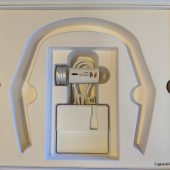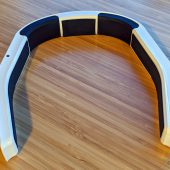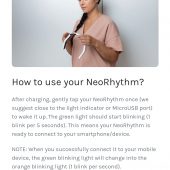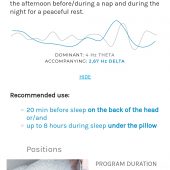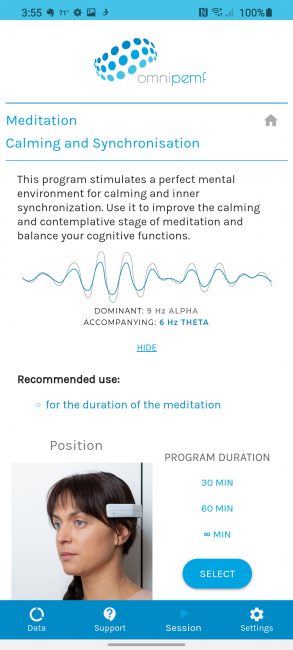The NeoRhythm Neurostimulation Headband is a wearable device that uses non-invasive technology to improve your sleep, improve your focus, help control pain, help you achieve deep relaxation, aid with meditation, and improve your energy and vitality in as little as two weeks of regular use. That’s a lot for one device to promise, right? But can it possibly deliver?
If the NeoRhythm Neurostimulation Headband can even do even some of the things that they mention, then the benefits of using this headband would be huge. So figuring out if NeoRhythm is a legitimate science-backed product that can give users a real benefit was what I set out to learn while doing this review. But first, a bit more about the product. Here’s the video they feature on their site.
NeoRhythm is a tPEMF (rTMS) device that “creates bursts of low-level electromagnetic waves that stimulate the brain to induce a desired state of mind (calmness, deep meditative state, focused state, etc.).” For those, like me, who have never heard these terms, tPEMF stands for Targeted Pulsed Electromagnetic Field Therapy, and rTMS stands for Repetitive Transcranial Magnetic Stimulation.
PEMF therapy was mentioned explicitly on the NeoRhythm site along with tPEMF therapy. I had to Google ‘PEMF Therapy‘ because I had never heard of it before, and confusingly when searching Google for “PEMF,” I was inundated with what appeared to be a ton of snake oil products, claims, and skeptical articles that made me question whether I should even bother continuing this review. But after reading through some of the blog posts on the OmniPEMF site that better explained their science, I learned that this device uses tPEMF (rTMS). Through tPEMF, NeoRhythm is supposed to be able to non-invasively and safely encourage the user’s brain to mimic the external signals provided by the device by entrainment, so I decided to forge on.
OmniPEMF has had two studies done to test the efficacy of the NeoRhythm headband (study one; study two). They were conducted by Igor Jerman, Primož Dov, and Petra Ratajc of the Physiological Testing Department at the Institute for Bioelectromagnetics and New Biology (BION), in Ljubljana, Slovenia regarding the NeoRhythm headset’s efficacy (this product launched on Indiegogo in 2019). I read the papers and was encouraged. So I went down the rabbit hole and started digging. I learned that there is an impressive amount of evidence that tPEMF/rTMS therapy can help with depression, as stated at the Biological Psychology, Mayo Clinic, National Institute of Mental Health, and many other sites; it is legitimate science. Perhaps most impressive was a study I found, which yielded 199 antidepressant drug-free patients with ‘unipolar nonpsychotic major depressive disorder’ (out of screened 860 outpatients). That study concluded that “daily left prefrontal rTMS as monotherapy produced statistically significant and clinically meaningful antidepressant therapeutic effects greater than sham.”
It’s important to mention that even mild depression, what many of us are likely feeling to some degree since this pandemic hit, can cause all kinds of unwanted symptoms. Those side effects can include insomnia, anxiety, inability to focus, mood changes, lack of energy, restlessness, trouble remembering things, body aches, and malaise, to name just a few.
I think it’s safe to say that many of the effects of depression are the exact things that the NeoRhythm Neurostimulation Headband is billed to help manage. I’ve certainly experienced several of these symptoms myself this year, and I’m betting that if you are reading this review, you have, too.
Deciding to give the device a chance, I moved forward with my research. Now I had to learn about brainwaves. We’ve all heard that our brains are computers, but they are also electrochemical organs. The human brain produces small amounts of electrical energy that are identifiable as naturally occurring neural oscillations, what we commonly call brainwaves. Brainwaves reflect the repeated electrochemical activity that is happening in our brains and central nervous systems at any given time, depending on what we are doing. These brainwaves can be evaluated in a medical facility with electroencephalography, or what’s commonly known as an EEG.
There are different categories, or frequencies, of brainwaves that fire up throughout the day as we do different things. The categories of brainwaves include Gamma, Beta, Alpha, Theta, and Delta. Each type of brainwave has a specific frequency and amplitude; while they are each always present to some degree, depending upon the activity we are engaged in a particular category will be more dominant.
Gamma brainwaves have the highest frequencies (30 Hz+) and are dominant in states with heightened perception. Beta brainwaves (14-30 Hz) are dominant when we are awake and our consciousness is normally alert. Alpha brainwaves (9-13 Hz) are dominant when we are relaxed – still awake but less alert and perceptive. Theta brainwaves (4-8 Hz) are dominant when we are in a state of reduced consciousness – light and REM sleep, dreaming or deep meditation. Delta brainwaves (less than 4 Hz) are dominant when we are in deep sleep without awareness of our surroundings.
What’s interesting to me is that these brainwave frequencies aren’t just a reflection of what our minds are doing at any given time. With their neurostimulation headband, NeoRhythm is saying that these brainwaves can also be manipulated if the user wants to heighten a particular brainwave category to produce or enhance the desired effect when wearing the headband in different positions on the head or neck.
NeoRhythm says that “with appropriate positioning of the coils inside the device which generate electromagnetic fields, we precisely target the right brain locations to get the desired effect.” I should mention that the NeoRhythm headband has five inverted coils strategically placed across the headband, to produce the “harmless electromagnetic fields that emit waves in patterns that your mind seeks to imitate.”
OmniPEMF does not seem to be advocating brainwave pseudoscience by saying that they can detect brainwave imbalances, nor do they seem to be saying that their headband can offer to “balance them.” I think this is important to point out because had these type claims been made, I would have dismissed the NeoRhythm immediately as quackery, even though the placebo effect of a hoped-for outcome from using the headband might be real.
My biggest issue for the past few months has been a lack of ability to focus for extended periods, coupled with some general anxiety about things that are happening around me and with people I love during the pandemic. I’ll admit that focusing has always been a problem for me, but I have managed to keep it under control by employing various coping mechanisms and self-reward-based systems that worked in tandem with hard deadlines. About a month after we went into isolation, I started to realize that my attention was hopelessly scattered all over the place. Like many, I was worried about things I couldn’t control, and I was allowing those thoughts to consume me, leading to anxiety. I have had days where it felt like an impossible task to center myself enough to be able to be productive. If the NeoRhythm could help me center myself enough to be on and focus, then I would consider it a success.
So how does the NeoRhythm replicate the particular brainwave rhythm that we want to enhance?
NeoRhythm has been carefully programmed by a team of scientists to generate specific dominant rhythm (through controlled medium-intensity magnetic fields with a gauss range of 20-25, and accompanying lower-intensity frequencies of 2.5-5 gauss) that mirror the mind’s naturally-occurring wave frequencies. Each frequency matches a “state of mind” that we associate with specific activities. In this way, you can choose your preferred state of mind by selecting one of the NeoRhythm programs, and your mind will seek to match NeoRhythm’s suggestion.
At this point, I was finally ready to open the box and begin the review process.
The box includes the NeoRhythm headband, a white mesh storage bag for your headband, a charging dock, a microUSB cable, an adjustment kit, a hard reset tool (basically a SIM tool), a glass tube with a testing magnet inside, and a user manual. (Click any picture to open a slideshow)
- A quick-start guide is printed on the box’s inner lid.
- Pads for a perfect fit.
- The included testing magnet.
Inside the user manual, there is a section that mentions the people who should not use NeoRhythm. Those who should not use the headband include anyone with a pacemaker or other electronic implants, those who have non-MRI-safe IUDs, people with cochlear implants, or those with mechanical heart valves. It makes sense because NeoRhythm produces a magnetic field when it is in use, which can shut those devices off or otherwise interfere with their functioning. They also say that those with epilepsy, Grave’s disease, or those who are actively bleeding should not use it. Further, people who have had organ transplants should not use it because there is a possible risk of electromagnetic fields stimulating the immune system, which could activate a more aggressive rejection process. Finally, because the safety of pulsed magnetic fields has not been established for those who are pregnant, they don’t recommend using it during pregnancy. You can read the full user manual here.
So assuming you don’t meet any of the criteria for not being able to use it, let’s continue. The NeoRhythm headset is shaped like a traditional headband. It’s about an inch wide and a half-inch thick; it weighs 4.1 ounces with the pads I added for a better fit, so it is not overly burdensome. The body is composed of matte white plastic with pads built in for proper fit and comfort. There are no electrodes or extra supplies that will need to be purchased at a later time, and if required, you can adjust the fit with the included adjustment kit pads.
The first step for getting started is to plug the microUSB cable into the charging base and a power source and then attach the headset to it. It took about 30 minutes for the yellow LED to stop glowing on the charger, so I suspect that the headband shipped with at least a partial charge; when the battery is fully depleted, it takes about 2.5 hours to charge it.
There is a NeoRhythm app available for both iOS and Android in their respective app stores that you’ll need, so the next step is to download that app and install it to your mobile device.
The app will walk you through the simple login (there is no account required, which was a pleasant surprise), as well as the initial pairing setup — which occurs nearly automatically. A couple of things will pop up that are worth noting. The first is that a fully-charged NeoRhythm will last 8 to 10 hours. Since the typical session can be 30 minutes to 60 long, depending upon the program you select, you’ll be able to use the headset for several days without recharging, or for at least a full night if you are using the 8-hour under-pillow sleep program.
To turn the NeoRhythm on, you’ll tap the headset once (they suggest that you do it by the LED next to the charging port). With the app turned on, you’ll then be directed to allow Bluetooth pairing between the device and your headset. You’ll have the option of leaving Bluetooth on so that you can access the app’s features during your session, including in-app usage statistics. However, you can also opt to turn Bluetooth off if you don’t want to have Bluetooth actively working while it is on your head. Once you are connected, you’ll have the option to choose what you are most interested in achieving during your session by picking from one of the seven simulation programs. Next, you’ll select the desired length for your session (30 or 60 minutes), and then you’ll tap your NeoRhythm twice to activate the program. Depending upon the program you decide to run, the app will tell you where to place the headset on your head for the proper benefits.
Let’s talk about the proper fit of the headband on your head before we go further. The NeoRhythm is designed to fit 90% of the people who might try to wear it, but the headband may need to be adjusted if you have a smaller head. I guess my head is slightly smaller than average because the headband felt just a little too loose out of the box. To fix that, I added the medium pads that were included in the adjustment kit.
Problem solved, moving on.
Now that you’re connected, the next step is to choose the stimulation program you are most interested in using. Included are: Enhance Mental Capacity, Energy & Vitality, Deep Relaxation, Improve Sleep, Pain Control, Meditation Theta, and Meditation Calming & Synchronization.
We’ll start with the Enhance Mental Capacity program, as it has become my morning go-to. I have had trouble concentrating and staying focussed enough to be consistently productive since we went into lockdown (ugh). As you can see in the screenshots below, this program is meant to improve your ability to focus and also help with problem-solving, data processing, and multitasking. They recommend it for use to help clear your morning mental fog and to help tackle any difficult mental challenges. Proper positioning for the headset during this program is across the top of your forehead, just above your hairline. According to the user manual, “changing the headband’s position for up to about an inch won’t decrease its effectiveness or interfere with functioning in any significant way.”
To begin the program, you just tap the headset twice near the LED light. The LED on the side will start blinking rapidly (about one blink per second), indicating that the stimulation program is running and the headband will vibrate twice; other than that, in this or any of the programs, you’ll probably not have any indication that anything is happening.
For someone like me, that’s torture. And that’s why the test tube with the little magnet inside is included. Because the non-invasive pulses don’t make any noise — and you certainly won’t feel anything while the program is running — you can use the test tube to see that something is happening. The way you do this is by running your desired program and placing the glassy end of the glass tube next to the headband (held with the magnet chunk in that glass end) and placing the screw-top end of the tube to your ear. Listening carefully, you’ll hear a tapping sound that will be slower or faster, depending on the program you are running. With the ‘Enhance Mental Capacity’ program running, for instance, you’ll hear a faster tapping; on the other hand, with the ‘Improve Sleep’ program, the tapping is much slower. Sliding the glass tube up and down the sides and bridge of the headband will produce more or less tapping, and it’s interesting to take a few moments to listen to it and play with where the magnet action is stronger or weaker. This video shows you how to do it.
When the program is finished, the headband will vibrate twice, so you’ll know to remove it. At the end of your session, you can hit the data tab at the bottom of the app, and it will show you the programs you’ve run so far that day; a calendar will function will also allow you to see the sessions you’ve run on previous days. I tend to believe that more is more, so I usually go for the 60 minutes sessions when they are offered. :shrug:
I have been using the Enhance Mental Capacity program when I first get to my desk in the morning. I feel silly wearing the headband, not gonna lie (my husband loves to tease me about it — rude), but I also feel a bit more alert after using it.
Let’s look at some of the other programs, as many of them utilize different headband placements.
Energy & Vitality: In this program, the headband is worn similarly to how it is worn for the Enhance Metal Capacity program. The program is meant to be used before or after intense physical activity, or when you are feeling tired and less energetic. I like to use it in the afternoon, as it offers a bit of a pick-me-up — it’s not quite as energizing as drinking a cup of strong black coffee, but there is definitely a noticeable benefit without any caffeine buzz.
Deep Relaxation: For this program, the headband is worn facing the back of the head, resting around the top end of the user’s occipital bone. This application is used to help promote relaxation and to de-stress.
Improve Sleep: There are two options here; you can wear the headband on the back of your head (again, resting near the top end of the occipital bone) for 20 minutes before you go to sleep, or you can opt to place it under your pillow for up to 8 hours. I like to use it before bed for 20 minutes, and that is generally enough for me to calm down enough to crash out.
Pain Control: For this program, the headband is worn around the user’s neck, resting on the shoulders. I don’t suffer from acute or chronic pain, though, so I can’t comment on its effectiveness.
Mediation Theta: For this program, the headband is worn more or less straight across the back of the user’s head. It is supposed to stimulate “a perfect mental environment for deep meditation.”
Meditation Calming & Synchronization: This program also requires the user to wear the headband more or less straight across the back of their head to “improve the calming and contemplative stage of meditation and balance your cognitive functions.” I haven’t had any hard-core anxiety in the last couple of weeks (which has been a relief), so I haven’t felt the need to use this function yet.
To get the most benefit from the system, for whatever reason you are using it, OmniPEMF recommends that you use the NeoRhythm daily for at least six weeks, but that you should start feeling results within two weeks. I’m well into my second week, and while I can’t quantify it, I do know that I feel a bit more energized, centered, and able to concentrate when I’ve finished a session. I’ve also noticed that I’ve been able to fall asleep more quickly (within 13 minutes or so versus 30, which was my average), and I have awoken feeling refreshed rather than sluggish — even on days where I didn’t specifically use the sleep program the night before. I haven’t had any headaches or hard-core nausea, which can be side effects of tPEMF therapy, but I do occasionally feel a fluttering of nausea or a random weird prickling sensation on the right side of my head. Both sensations pass quickly.
If you have been having trouble with stress, concentrating, or falling asleep, I can recommend the NeoRhythm Neurostimulation Headband. It’s weird looking, and it seems too simple to do anything, but putting it on and having a session for whatever my desired effect has been — just a couple of times a day — has really helped me. The headband is comfortable, and you can wear it while working or driving. Best of all, OmniPEMF offers a 60-day money-back guarantee; if you don’t feel like it is helping, you can send it right back for a refund. You’ve got nothing to lose trying it, and if it also works for you, you can thank me later.
The NeoRhythm Neurostimulation Headband retails for $309, and it is available directly from the manufacturer. They offer free shipping and a 60-day money-back guarantee so you can try the headband to see if it helps with no risk.
Source: Manufacturer supplied review sample
What I Like: Relatively inexpensive with no additional equipment to purchase later; It is easy to operate; No extra equipment to fumble with (e.g., sticky electrodes); It doesn’t make noise, so it is perfect for wearing while trying to write; You can wear it pretty much anytime, even while driving; I have noticed better focus and concentration (which ultimately means less stress for me) as well as better sleep since I started using it
What Needs Improvement: You may experience a little bit of nausea when the programs first start, but it passes quickly




